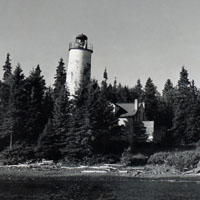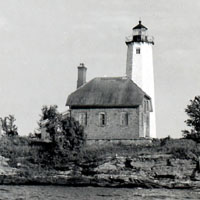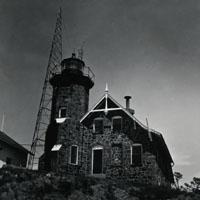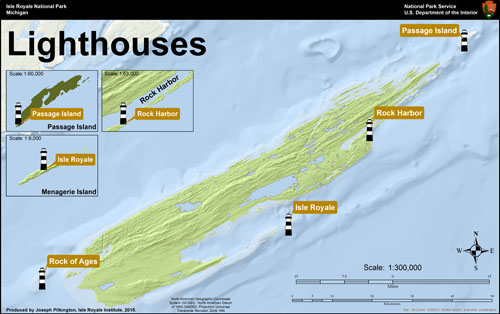Panoramic001.jpg)
Lighthouses
Guardians of the Light
The Isle Royale archipelago, consisting of more than 450 islands, has many shallow, rocky reefs and was historically in the path of major shipping lanes. This made the island a natural place for lighthouses, especially when copper mining was at its peak during the mid to late 1800s. Yet, even the presence of lighthouses has not always been enough to keep ships from courting disaster. Ten major shipwrecks ring the island, and numerous other small boats rest in park waters.
Although all lighthouses today are unmanned, they were once home to the keepers of the lights. The keepers were tasked with alerting ships to danger, and rescuing survivors of shipwrecks. For many, it was a lonely job in a remote setting, facing endless days of fog and tumultuous weather. Most served only during the navigation season, around the end of April through mid-November, and spent their winters on the mainland. The keepers were a hardy breed, guardians of the lights, often making the difference between life and death for those crossing Lake Superior. In honor of these brave keepers and the lighthouses they safeguarded, all four Isle Royale Lighthouses are listed on the National Register of Historic Places.
Rock Harbor Light

Although no longer illuminated, the Rock Harbor Light at the southwest entrance to Rock Harbor is the most viewed and visited lighthouse. Completed in 1855, it features a 50-foot white round brick tower with a black lantern. The tower is attached to a keep's house that now serves as a museum. A Fourth Order Fresnel Lens once sent out a beacon of light for 15 miles across the lake. In 1859, as copper mining declined, the Rock Harbor Light was shut down, but the light was rekindled in 1874 when copper mining resurged. In 1879, it was permanently closed, but remains a popular tour stop for visitors today.
More Info
Isle Royale Light (Menagerie)

The Isle Royale Light stands on long, rocky Menagerie Island via Isle Royale's south shore at the entry to Siskiwit Bay. Reachable only by private boat, it features a 61-foot double-walled octagonal sandstone tower, with a black lantern and gallery. It was completed and operative in 1875, and automated in 1913. The original Fourth Order Fresnel lens and subsequent light systems have been replaced with a 12-volt solar power 300 mm Tidelands Signal Acrylic Optic, which sends its beam out 10 miles.
More Info
Rock of Ages Light

Just outside Washington Harbor stands the Rock of Ages Light, which began operation in 1908. The 117-foot white cylinder-shaped lighthouse is composed of steel, concrete, and brick, with a black base and lantern. To build this lighthouse on a 50-foot by 200-foot rocky outcrop was a tribute to the engineering of the time. In 1909, a Second Order Fresnel lens replaced the first, temporary Third Order fixed red light. Today, the unmanned lighthouse features a 300 mm Tideland Signal Acrylic Optic lens that runs on solar power. You can view the stunning old Second Order Fresnel lens at the Windigo Visitor Center.
More Info
Passage Island Light

On the northeast side of the park, the Passage Island Light guides ship traffic between the channel of Isle Royale's main island and Passage Island. Completed in 1882, the lighthouse originally used a Fourth Order oil-burning wick lamp and appeared as a fixed red light; later, it was modified to a flashing white light. Concession tours regularly travel to the island, giving visitors a glimpse of this now automated and unmanned sentinel of the past that continues to provide safe passage to ships today.
More Info
Close Calls
Isle Royale Lighthouses are symbols of survival-and occasionally, literally the very means of survival. On a foggy day in 1933, the George M. Cox ended its maiden voyage by striking a reef close to the Rock of Ages Light. Keeper John Soldenski took his boat out to the wreck, then towed the lifeboats to the rocky outcropping where the lighthouse is located. The lighthouse became a makeshift hotel, in which about 120 survivors of the wreck took turns spending the night alternating between huddling on the tower's spiral staircase and shivering outside.
Sometimes, it was the keepers' families who struggled for survival. In 1883, toward the end of the navigation season, Passage Island Light Keeper W. Dermant took his boat to Port Arthur to pick up supplies. When the Lake froze, he was unable to return until spring. His wife and three children were left to fend for themselves through the winter by fishing and hunting snowshoe hares. Dermant left his duties shortly after the rescue of his family.
Supply channels for those keepers during the early years of operation were undependable. During one tough season, a crew of four lighthouse keepers at Rock of Ages Light was down to one last can of tomatoes before they were taken off the island for the winter. Now that's a close call!
Citations:
- National Park Service, U.S. Department of the Interior. Isle Royale National Park Lighthouses. N.p.: National Park Service, U.S. Department of the Interior, n.d. Print.
